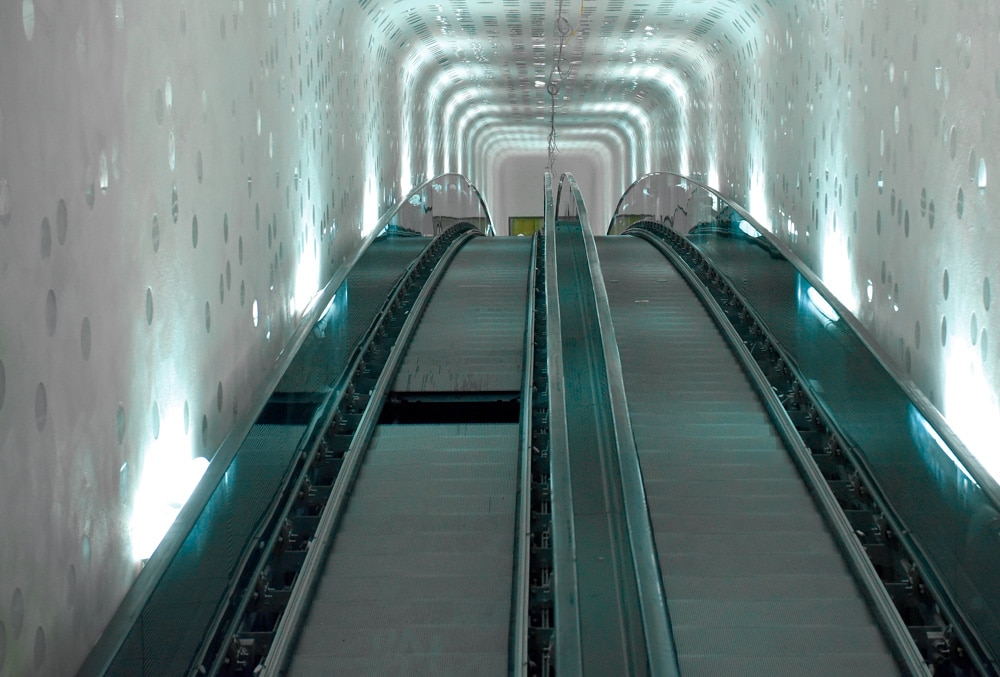Arched Escalators at the Elbe Philharmonic Hall
Apr 1, 2016

World’s first arched escalators installed in new Hamburg landmark.
KONE provided a pair of unique escalators for the under-construction Elbe Philharmonic Hall by the Elbe River in Hamburg, Germany. Considered a future landmark, it will be the tallest inhabited building in Hamburg, with a final height of 110 m. The building will also include a hotel and apartments in the upper floors, in addition to the concert hall.
KONE began work on the installation in 2007, when its Essen, Germany-based engineering team was contracted to design and provide the world’s first arch-shaped escalators. Construction stalled between 2010 and 2011, then between 2014 and 2016 due to contractual issues, but now the building is scheduled to be opened in early 2017.
These two units are based on KONE E3X technology and are 80 m long, stretching from the ground to the sixth floors with a floor-to-floor height of 21.43 m. Their curvature radius is 210 m with an initial incline of 26.5° that decreases to 8°. This design succeeded in fulfilling the architect’s vision of an escalator with a top not visible from the bottom using the bow-shaped design. Consequently, during the 2.5-min. journey (at a speed of 0.5 mps), visitors cannot see from one end to the other, irrespective of the direction in which they look.
Lifting the escalators into the building also proved to be quite a spectacle, involving a tower crane hoisting them up to the top of the 38-m-tall plaza in which they reside. The plaza serves as a viewing platform and distribution level from which the concert halls, the hotel, apartments, the conference center, the wellness area, restaurants, cafés and bars can be reached. Visitors cover the first section of the route with the arched escalators, which run from the main entrance through an 80-m-plus-long tunnel up to a 30-m height to the intermediate level with a view of the landing piers.
The tunnel, called the “Tube,” consists of light plaster and 7,900 iridescent glass paillettes that are set off by light emerging from the structure’s ends. Two additional escalators, ECO3000 KONE units, continue the journey from the intermediate level. These “plaza escalators” have an incline of 17.25° and are 21.10 m in length and 4.32 m tall. They take visitors through the second “small tube” almost to the plaza as they enjoy the custom guide rails, balustrades and bases. Visitors then ascend a stairway with 15 more steps to the plaza.
Technology in the Arched Escalators
At a length of 80.2 m, the arched escalators are the longest installation in Germany and Western Europe. Their length and height, combined with their arched form, required exceptional constructional effort. The KONE design team led by Dr. Heiner Zeiger developed them in just under a year. The truss had to be cut to size on the spot. Additionally, the sectional drives (with special drive wheels and sensors), step chains, base and controller unit were custom made. Other components were part of normal serial production.
Before installation of the arched escalators, a 1:1 model was created in 2008 to clarify the practicality of the design details, including the step chains and interplay of sectional drives and controller unit. Since the test escalator was designed to be as realistic as possible, many of its components, including three of the five handrail and step-chain drives, four truss elements and the loading station for the step band, were reused. Consequently, the escalators are truly global products: truss, drive components and other components were delivered from China, and longstanding German suppliers provided drive components, step chains, controls and converters.
Drives and Controls
Total requisite power for the arched escalators was calculated at 60 kW — seven-and-a-half times that of a normal shopping-mall escalator. To distribute the load more evenly on the chain, the chain was made lighter. In this way, the power was not located on a single drive at the top, but instead distributed over four sectional asynchronous drives along the truss.
Even in normal operation, every escalator has to master enormous loads: if a 75-kg adult is standing on each of the nearly 200 visible steps, the drives move 15 mT. However, the system was designed for 120 kg per step for a total load of 23 mT. As a result, the reserves are sufficient, even in the event of evacuation.
The 165.40-m-long handrail is powered by two drives, including one of the step-chain drives. In this way, one drive is saved, and the synchronization of the handrail and step chain is ensured. The two drives, located at the top and bottom ends of the truss, ensure that the handrail always sits evenly on the guide and is not pushed out at the ends of the balustrades.
A special controller that communicates between the central control unit, drive converters and drive sensors (via a bus system) was needed to synchronize all of the drives. Through it, the four escalators can facilitate total evacuation of the Elbe Philharmonic Hall: in the event of an emergency, the building control center can switch them to operate in one direction only. The collection areas at the ends of the escalators were designed to be correspondingly large as part of emergency evacuation planning. Step height design was also part of this planning to retain the escalators’ suitability as part of the escape routes. For the arched escalators, the step heights vary (depending on the inclination angle) between 56 and 179 mm. In the event of emergencies or the end of a concert when there is heavy traffic, the escalators can also speed up — from 0.3 mps at night or 0.5 mps during the day to 0.63 mps.
Inspection Organization Involvement
The complexity of the project led to an early decision to bring in an inspection organization beginning with the installation of the escalators. The involvement of TÜV Rheinland Industrie Service GmbH included three site inspections with TÜV conveyance technology department head Achim Hüsch, the last of which took place in May 2015. KONE had to analyze and document the requirements of the technical standards for the arched escalators in a detailed analysis, as codes such as EN 115-1 do not include specific requirements regarding arched escalators.
The integration of all four escalators in the evacuation concept also required coordination. For example, could the escalators still be used as part of the escape and rescue route, considering the variable height of their stair risers? Eventually, the Hamburg building standards authority answered this in the affirmative. Another subject was the realization of the safety-relevant control functions and their integration into the escalator controls, which were unusually complex on account of the multitude of drives.
New Possibilities
KONE feels the planning and execution of the arched escalators opened completely new avenues for it. The construction principles applied in the project could lead to designing escalators and moving walks in even more complex forms, such as waves. For future escalators with extreme rises, the sectional drives can permit dispensing with room-sized central drives in favor of smaller, standardized components. In this way, the use of transmission oil can be limited to a fraction of the usual quantity. In the case of the escalators at the Elbe Philharmonic Hall, this figure was one-third.
Get more of Elevator World. Sign up for our free e-newsletter.







